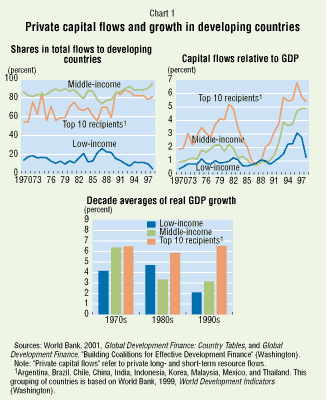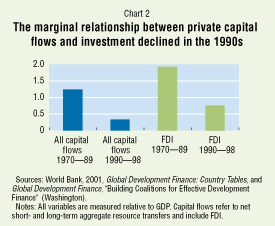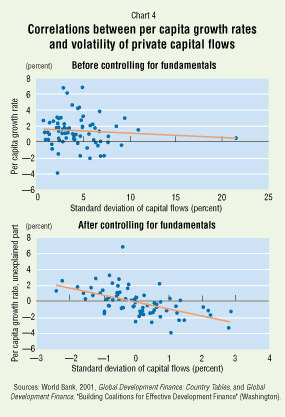 About F&D Subscribe Back Issues Write Us Copyright Information |
Private Capital Flows and Growth Deepak Mishra, Ashoka Mody, and Antu Panini Murshid International capital flows have increased dramatically in recent years, but their impact on developing countries has not been clear. Whereas capital flows have been associated with higher growth in some countries, they have also been associated with a higher incidence of crises. Do the benefits justify the costs? In the second half of the 1990s, several countries experienced financial crises in an environment of increased international capital flows, casting doubts on the ability of such flows to stimulate long-run growth in developing economies. Although the volatility of capital flows does inhibit growth, there is some evidence that countries are learning to manage volatility better. Thus, the rather relentless process of global financial integration offers the possibility of a growth dividend; such a dividend is not automatic, however, but must be earned. Moreover, as countries open up their capital accounts, an increase in capital outflows and a change in the composition of flows imply that the growth-enhancing impact of capital flows will evolve. Their main impetus will shift from stimulating growth through additional investment to enhancing productivity. The impact of capital flows on growth is influenced by whether domestic policies are improving over time, how quickly countries are relaxing capital controls, and the degree to which the composition of flows is changing. Most developing countries have participated in the global increase in capital flows, especially in the 1990s (see Chart 1), when capital inflows to developing countries as a group increased sharply. However, the share of private international capital going to low-income countries fell from already quite low levels, as did these countries' growth rates. Over the same period, the top 10 recipients acquired a greater share of private capital, and their growth rates increased.

It is difficult to say unequivocally that private capital flows drive growth; indeed, we believe that domestic growth often drives capital flows. The evidence suggests, however, that private capital flows can reinforce the growth process. Thus, as global integration advanced in the 1990s, the distribution of benefits from international capital flows accentuated income differentials between countries, mirroring events of the earlier episode of significant globalization that occurred about a century ago. Capital flows and domestic investment Economic theory suggests that capital will move from countries where it is abundant to countries where it is scarce because the returns on new investment opportunities are higher where capital is limited. Such a reallocation of capital will boost investment in the recipient country and, as Summers (2000) suggests, bring enormous social benefits. Underlying this theory is the premise that returns to capital decrease as more machinery is installed and new structures are built, although, in practice, this is not always, or even generally, true. New investment is more productive in countries with a skilled workforce and well-developed physical infrastructure, as Lucas (1990) recognized in explaining why capital does not flow from rich to poor countries. Thus, a consistent finding is that new capital flows tend to go to countries that have received large flows in the past and that investors also seek favorable business environments (Mody and Srinivasan, 1998). It is therefore not surprising that capital flows to low-income countries are declining. Although economic theory and empirical investigations have much to say about where international capital may flow, both the theory and the evidence are less definitive about the impact of such flows. Once in a country, private capital may increase either domestic consumption or investment, or it may principally increase the country's foreign exchange reserves. If flows are driven merely by incentives to evade taxes or jump other legal barriers, money may flow out of a country as quickly as it flows in. Despite these ambiguities, private capital flows are generally found to have a significant impact on domestic investment, with the relationship being strongest for foreign direct investment and international bank lending and weaker for portfolio flows (Bosworth and Collins, 1999). When a country is poor and saves little, additional capital from outside the country can help it realize investment opportunities. For example, our analysis suggests that a 1 percent increase in capital inflows to Africa boosts investment by more than 1 percent. However, little foreign capital is directed to Africa, and that is largely limited to a few countries with significant natural resources. Moreover, because the productivity of investment in many of these countries is not high, the long-term impact of foreign capital on growth may be small. Over time, as a country becomes better integrated with the rest of the world, a dollar of foreign capital raises investment less than it did in the past (Chart 2). This shift has several explanations. First, the composition of capital flows is changing. Foreign direct investment is being used less for "greenfield" projects (construction of new factories), while mergers and acquisitions have become more common. At the same time, the share of portfolio capital in total inflows has increased. Second, countries have recently built up larger foreign exchange reserves, partly in response to the greater need for liquidity to ward off financial crises resulting from sudden flights of private capital. And, third, capital outflows are apparently increasing. Outflows are not well captured in international statistics, but it appears that traditional "flight" of domestic capital and "round-tripping" (that is, when capital flows out and then flows back in) to escape domestic taxes are not the only reasons for outflows. Some part of the capital flows represents a diversification of investment portfolios by domestic residents and, ultimately, benefits both the residents and the global economy.

Productivity While the relationship between private capital flows and domestic investment has weakened, it appears that private capital flows are enhancing productivity more than they did in the past. Chart 3—a partial scatter plot showing the relationship between growth on the one hand and capital inflows and GDP on the other—does not control for a number of traditional variables for growth, including the domestic investment rate. In the 1990s, countries with above-average ratios of capital flows to GDP also had above-average growth rates.

The evidence is firmer on the conditions under which productivity benefits accrue, and the clear implication is that the productivity benefits are greater in countries with a skilled workforce and well-developed physical infrastructure. For example, studies show that in Malaysia, Taiwan Province of China, and the southeastern provinces of China, foreign direct investment boosts productivity. In contrast, studies on Morocco, Tunisia, and Uruguay do not find similar benefits. Indeed, there is some evidence that, following the entry of foreign firms, domestic firms do not gain "spillover" benefits from the knowledge that may accompany the newly arrived firms. Instead, they lose market share, and the consequent contraction lowers their productivity (Aitken and Harrison, 1999). Within countries, firms with greater research and development capabilities are better able to absorb the benefits that result from the presence of foreign firms. These microeconomic studies are supported by the cross-country regression findings of Borensztein, De Gregorio, and Lee (1998), who determine that foreign direct investment is more productive in countries with a better-educated labor force. In a recent review of the literature, Eichengreen (forthcoming) also finds that studies support the hypothesis that private capital flows are more efficient in higher-income countries. Similarly, the evidence suggests that private capital flows—especially portfolio flows—have been associated with the development of domestic capital markets, which, in turn, bolster growth. However, private capital flows can increase the vulnerability of a country with weak financial markets to banking and exchange rate crises. Volatility The financial crises of the second half of the 1990s that threatened, at times, to engulf the global financial system served as a reminder, if one were needed, that significant and expensive accidents are possible. Although these crises led to spectacular short-term declines in output, the evidence also suggests that ongoing volatility of capital flows (a higher variation, measured by the standard deviation, of such flows) is associated with lower long-term growth. Chart 4 presents such evidence, which, again, should be treated as suggestive rather than conclusive.

The volatility of capital flows may arise from either domestic or foreign sources, with some arguing that domestic causes predominate. Policy shifts, for example, drive movements in capital flows; when such shifts are frequent and unpredictable, volatility will be high and growth low. In such a view, volatility itself is not to blame—it is only a symptom of domestic policy deficiencies. At the other extreme is a view that recent movements in capital flows bear little relationship to changes in countries' economic fundamentals and that the capriciousness of the flows reflects changes in global liquidity conditions and "herd-like" investor behavior. An intermediate position links domestic weakness—particularly in the financial sector—with imperfections in the allocation of global capital flows. This relationship affects, in particular, those countries that are liberalizing their domestic financial sectors at the same time that they are opening up their economies to external capital. This last perspective has led to the now widely accepted importance of strengthening the domestic financial sector as a country integrates financially with the rest of the world. Although financial crises in the second half of the 1990s attracted a great deal of attention, the long-term volatility of capital flows (the standard deviation of such flows), though high and slightly increasing in some countries, fell in some parts of the developing world. The indications of a flattening out of volatility and the perception that some countries have recovered relatively quickly from the depths of crises have led observers to conclude that countries have become better able to deal with volatility over time (Cline, 2000). This may be because countries have become more diversified in their production structures; or because the more widespread practice of allowing exchange rates to float causes growth to resume more quickly; or because greater awareness of the need for safeguards has induced policymakers to maintain greater international liquidity, strengthen financial sectors, and tax capital inflows in order to limit the most volatile ones. Conclusion The premature celebration of the boom in capital flows in the first half of the 1990s has been replaced in recent years by a skepticism that is equally unwarranted. Private capital flows are not likely to solve all development problems and can impose significant costs. However, when harnessed effectively, they can boost investment and spur productivity growth. Domestic policy priorities that foster more efficient investment will also attract productive foreign capital. Ultimately, domestic strength, including a robust and prudent financial sector, will also protect a country from the volatility induced by capital flows. However, special safeguards, such as higher foreign exchange reserves or contingent credit lines, may be advisable in certain situations.
This article draws on "Building Coalitions for Effective Development Finance," Global Development Finance (Washington: World Bank, 2001). References:
|